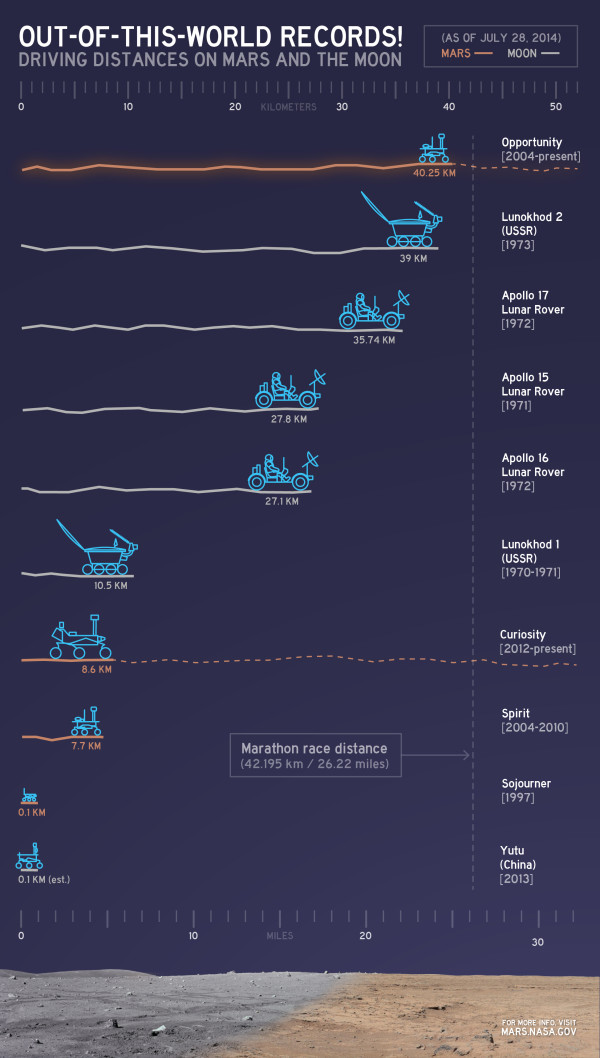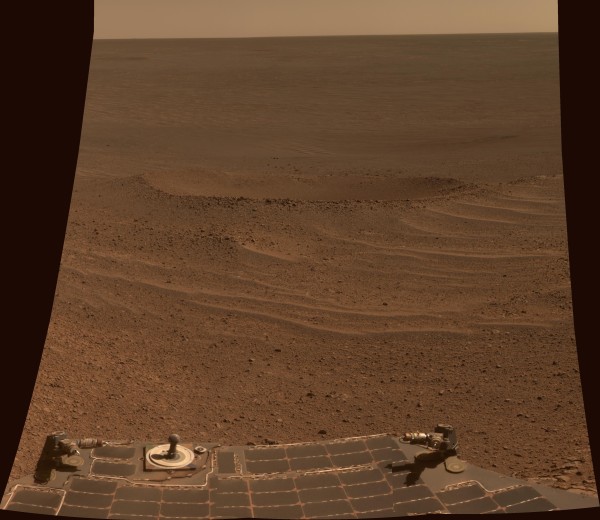“In any field, find the strangest thing and then explore it.” -John Archibald Wheeler
It's been over a decade, nearly a hundred thousand turns of its wheels and an unprecedented journey that still continues. But finally, after all this time, the Mars Opportunity rover has arrived.
Not anyplace that isn't just like something it's seen hundreds of times before; this crater is run-of-the-mill if anything is. But after more than 10 years, Mars Opportunity has finally broken the distance record for a roving spacecraft of any type on a world other than our own!
 Image credit: NASA / JPL-Caltech, via http://mars.nasa.gov/.
Image credit: NASA / JPL-Caltech, via http://mars.nasa.gov/.
Go take a look back at Opportunity, its story and its remarkable discoveries (and pictures) here.
- Log in to post comments
More like this
"In any field, find the strangest thing and then explore it." -John Archibald Wheeler
Sometimes, things get difficult. Sometimes, there are challenges you have to face that you never even expected, much less were prepared for. And sometimes, it seems like there's no point in even holding on to hope…
"You better lose yourself in the music, the moment
You own it, you better never let it go
You only get one shot, do not miss your chance to blow
This opportunity comes once in a lifetime yo" -Eminem
Here on Earth, a cold, frozen winter lasts three months, with the Sun's rays pointed a maximum of 23…
“We are much closer today to being able to send humans to Mars than we were to being able to send men to the moon in 1961, and we were there eight years later. Given the will, we could have humans on Mars within a decade.” -Robert Zubrin
This is what we can accomplish when we invest in something…
Can you imagine driving around on roadless terrain with a four wheel drive vehicle for eight years and not ever changing a tire, getting a tuneup, adjusting the suspension, replacing the hydraulics or brakes, or doing any other service whatsoever on your vehicle? I've actually done that, and I'm…





Some additional information about the cleaning events:
http://en.wikipedia.org/wiki/Cleaning_event
"The term started being used in 2004 as the Mars Exploration Rovers' solar panels started to benefit from these events."
"Cleaning events can either be rapid, such as overnight, or over many days where solar power slowly goes up."
These weekly reports (Opportunity rover) go all the way back to the start of exploration:
http://mars.jpl.nasa.gov/mer/mission/status_opportunityAll.html
http://mars.jpl.nasa.gov/mer/mission/status_opportunityAll_2005.html
May 13, 2005
"During sol 456, power engineer Eric Wood happily recognized a cleaning event."
This illustrates that dust cleaning events were recognized from very early on in the mission.
The dust cleaning events are recognized by the increase in power output.
Of course, the dust cleaning events occur at random.
I assume that it was rare for mission control to direct the rover to take a picture of its solar panels.
On one occasion, when a picture had been taken of dust covered solar panels, a major cleaning event occured soon after. That allowed a spectacular before-and-after comparison.
The cleaning events occur at random, but they occur so often (pretty much every month) that mission control has no worries that the solar panels might get to dusty.
The power output of the solar panels affects how much the rover can travel on a given day.
Thankyou, Ethan. That's the sort of information lacking down here on the land of Oz media. Seems to be a lack of interest (?) maybe. Opportunity might surprise us with a few more years of good service.
http://www.newscientist.com/blogs/shortsharpscience/2008/11/why-dont-th…
Henry Spencer describes that the design team did indeed consider dust removal optionss, and why they had to decide against them
- Not enough was known about Mars dust. What if static charge makes it cling to the surface?
- The weight of some dust removal mechanism (an arm, or tilting and shaking the panels) would go at the expense of other components.
- After two back to back failures the MER development schedule was hastened. A dust removal mechanism would add to the design workload, without knowing whether it would do any good.